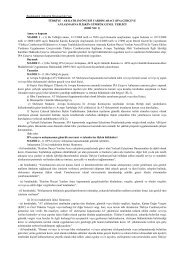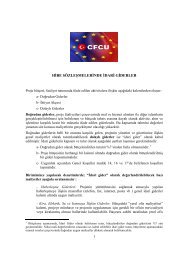Project Cycle Management Training Handbook - CFCU
Project Cycle Management Training Handbook - CFCU
Project Cycle Management Training Handbook - CFCU
You also want an ePaper? Increase the reach of your titles
YUMPU automatically turns print PDFs into web optimized ePapers that Google loves.
60<br />
<strong>Project</strong> <strong>Cycle</strong> <strong>Management</strong> <strong>Training</strong> <strong>Handbook</strong><br />
Mechanisms for communication must be established to ensure that the<br />
necessary information is generated and utilised in a timely and<br />
effective manner. Two important types of mechanism are:<br />
♦ <strong>Project</strong> progress reports - these are periodic summaries (perhaps<br />
weekly, monthly or quarterly) of project progress incorporating key<br />
information from the physical and financial indicators included in<br />
the logframe, activity schedule and cost schedule. It is not<br />
sufficient for team members to report simply that ‘things are going<br />
according to plan’. They must also provide the evidence of this.<br />
♦ Progress review - get together on a regular basis to review<br />
progress against the plan. This may be an opportunity for written<br />
reports to be presented and discussed, or simply for a rapid oral<br />
assessment of current issues and problems. However, reviews can<br />
be damaging if they are too frequent or too drastic. The temptation<br />
is often to go back to the plan and adjust it in the light of<br />
experience. This is acceptable up to a point, but if you find yourself<br />
spending more time planning than doing, then you have obviously<br />
got the balance wrong. It is also at times of crisis that organisations<br />
focus more on task accomplishment and forget about the process.<br />
Try to build on achievements rather than just continually adjusting<br />
the plan.<br />
Progress Reports<br />
Progress reports are usually written in a standard format allowing for<br />
comparison between reports over time 9 . The contents of the reports<br />
should match closely the logframe and its related outputs - ie. the<br />
activity schedule, budget and cost schedule. In each of these, targets<br />
will have been set: in the logframe, indicators of achievement<br />
(specifying quantity, quality, time) will have been identified at the<br />
levels of results, project purpose and overall objectives; while in the<br />
activity schedule milestones will have been established for the<br />
9 See p62, <strong>Project</strong> <strong>Cycle</strong> <strong>Management</strong> Manual, CEC, 1993<br />
Add your own notes here…





